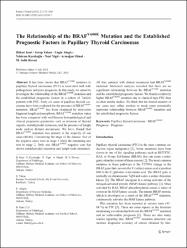The Relationship of the BRAF(V600E) Mutation and the Established Prognostic Factors in Papillary Thyroid Carcinomas

Göster/
Erişim
info:eu-repo/semantics/closedAccessTarih
2012Yazar
Kurt, BulentYalcin, Serap
Alagoz, Engin
Karslioglu, Yildirim
Yigit, Nuri
Gunal, Armagan
Deveci, M. Salih
Üst veri
Tüm öğe kaydını gösterÖzet
It has been shown that BRAF(V600E) mutation in papillary thyroid carcinomas (PTC) is associated both with pathogenesis and poor prognosis. In this study, we aimed to investigate the relationship of the BRAF(V600E) mutation and the established prognostic factors in a cohort of Turkish patients with PTC. Forty-six cases of papillary thyroid carcinoma have been evaluated for the presence of BRAF(V600E) mutation. BRAF(V600E) has been examined by restriction fragment length polymorphism. BRAF(V600E) mutation status has been compared with well-known histopathological and clinical prognostic parameters such as invasion of thyroid capsule, extrathyroidal extension, and the presence of lymph node and/or distant metastasis. We have found that BRAF(V600E) mutation was present in the majority of our cases (40/46). Considering the stage of the disease, five of the negative cases were in stage 1 while the remaining one was in stage 2. Only one BRAF(V600E) negative case has shown extrathyroidal extension and lymph node metastasis. All four patients with distant metastasis had BRAF(V600E) mutation. Statistical analyses revealed that there are no significant relationship between the BRAF(V600E) mutation and the established prognostic factors. We found a relatively higher BRAF(V600E) mutation rate in classical type PTC than in other similar studies. We think that the limited number of our cases may either weaken or mask some potentially important relationship between BRAF(V600E) mutation and the established prognostic factors.

















